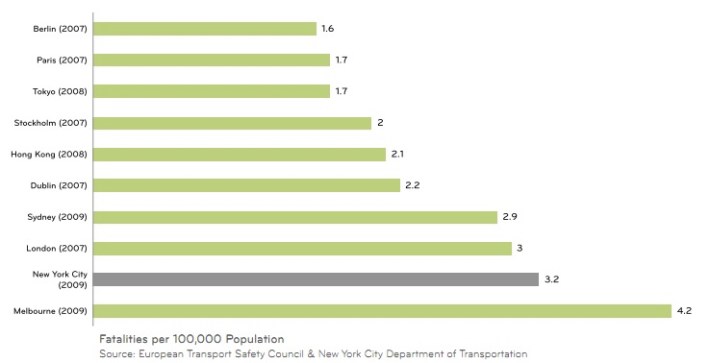
Traffic deaths need to be treated as an ethical imperative to save lives, said representatives from Transportation Alternatives, the Drum Major Institute, and the medical community today at the public release of the new report, "Vision Zero" [PDF].
"It is simply unacceptable for people to die in traffic," said T.A. Executive Director Paul Steely White, who called for the number of fatalities and serious injuries caused by traffic crashes in New York City to be brought to zero by 2030.
New York City has made impressive gains at improving traffic safety over the last decade, and has the safest streets in the United States. Yet compared to international leaders, the city still lags. In New York, 190 people are injured in traffic crashes on city streets every single day. Ten of them suffer life-altering injuries, losing a limb, perhaps, or receiving traumatic brain damage. Every 35 hours, someone is killed.
"These are all preventable injuries and preventable deaths," said Mt. Sinai pediatrician Michael Chatham Stevens. "As the CDC [Centers for Disease Control] says, this is a winnable battle."
To save lives and prevent as many serious injuries as possible, the report authors argue, New York City needs to first comprehend and then communicate the moral implications of allowing violent traffic crashes to continue, when available solutions have already been demonstrated and proven. While dramatic reductions in traffic deaths are within reach, the necessary changes require a coordinated response -- including engineering, enforcement, and legislative actions -- that cannot succeed without widespread public understanding and buy-in. At a time when local electeds are mobilizing against proven safety measures, the Vision Zero report suggests that the moral necessity of stopping preventable deaths and injuries should guide a campaign to capture the public imagination and sustain political commitment.
The report calls for the mayor to make a high-profile speech committing the city to a "vision zero" policy where traffic deaths are no longer tolerated. Right now, said White, life-saving traffic redesigns are routinely weighed against the convenience of an additional parking space. "By adopting Vision Zero," he said, "we put this on a moral plateau."
The Vision Zero approach earned the support of many members of the medical community. "Street safety is a major public health concern," said Dorian Block of the New York Academy of Medicine. In addition to saving lives directly, said Block, safer streets would help promote physical activity, reduce chronic diseases, and make it easier for New Yorkers to age in place.
Vision Zero would mark a radical acceleration of the city's street safety goals. While the city is currently committed to halving the number of traffic deaths by 2030, White called for eliminating deaths and serious injuries entirely by that time. Halving the number of traffic deaths should happen in the very near future, said White.
Cutting the number of road deaths in half is an eminently achievable goal, the report shows. Cities like Berlin, Paris, and Tokyo already have achieved traffic fatality rates half of New York City's. "The cost of inaction is 100 lives a year," said the Drum Major Institute's John Petro. "We need to accelerate the schedule." Paris cut its traffic fatality rate in half in only six years, pointed out Petro.
"We can in fact achieve Vision Zero," said White. While certain interventions have had dramatic results (20 mph speed zones reduced road deaths and injuries in London by 42 percent, according to the report, while speed detectors reduced fatal crashes by 65 percent where installed in France), the goal of zero serious injuries in traffic crashes has not been achieved elsewhere. After Sweden launched Vision Zero as a national campaign in 1997, traffic deaths fell 34 percent by 2009. The country has pushed back its initial goal of achieving zero deaths, shifting the target date from 2020 to 2050.
After the event, White said that Vision Zero could serve as more of an ethos than an achievable goal. A good model, he said, might be construction site safety or air travel. When people are killed while repairing a road or in an airplane, said White, "heads are rolling, there's an investigation." Vision Zero might not eliminate serious traffic injuries, but it can mean that no serious injury is ever again considered acceptable.
"No family should have to endure the pain and sorrow that myself and others have had to suffer," said David Shepherd, whose fiancee was killed by a speeding hit-and-run driver while walking in the Bronx in 2009. "We need the mayor."






